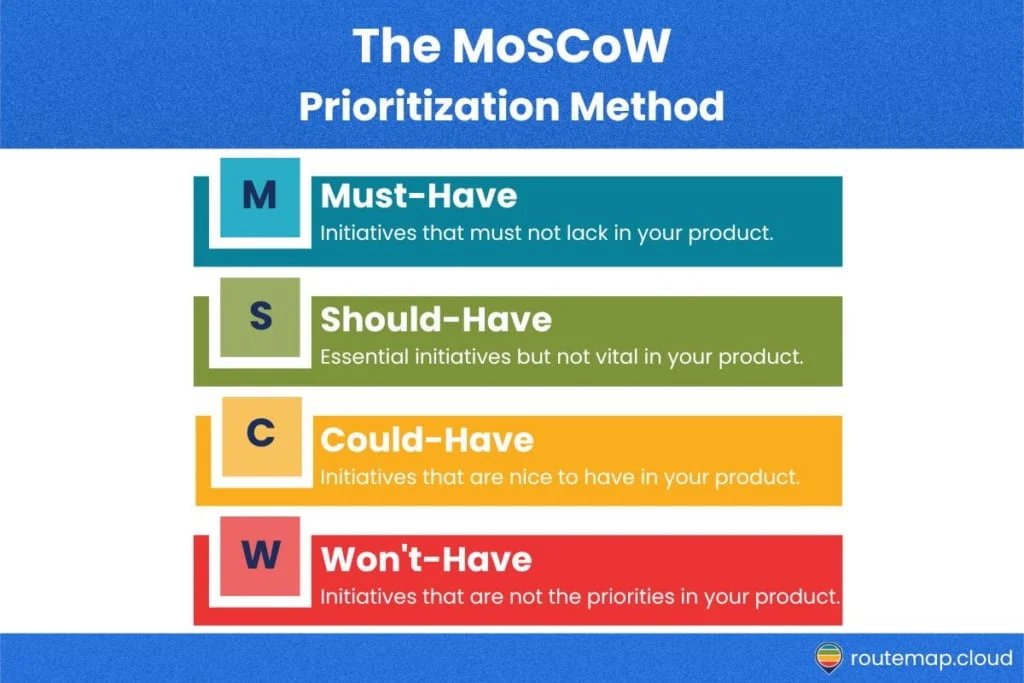Understanding the MoSCoW prioritization | How to implement it into your project
Hi community, it’s Lucas from DevSamurai and I would like to bring you a closer look at one of the popular prioritization methods: MoSCoW. In this article, we will discover what the MoSCoW method is, its benefits, and how you can implement it into your project for better management.
Projects, irrespective of their size or complexity, often juggle numerous tasks and requirements. In such a scenario, MoSCoW prioritization becomes essential to ensure the successful completion of the project.
Besides, it is also a very effective way to manage project priorities. With a straightforward and adaptable approach, the MoSCoW method helps manage stakeholder expectations and improve project outcomes.
What is the MoSCoW prioritization technique?
The MoSCoW method is a prioritization matrix widely used in project management and software development. The term MoSCoW is an acronym that stands for Must have, Should have, Could have, and Won’t have, each denoting a level of priority.
Here is the breakdown of the MoSCoW method:
- Must have: These are critical requirements that the project cannot be completed without them. If these are not fulfilled, the project is considered a failure.
- Should have: These are important but not critical features of a project, and these are high-priority items that are not as time-sensitive as the Must-haves.
- Could have: These are desirable features that do not affect the overall project’s success. Therefore, they can be included if time and resources permit.
- Won’t have: These features are the lowest priority or are not necessary for the current delivery cycle. They are agreed upon and recognized but are dropped for the project’s current timeline.

The method’s roots trace back to the Dynamic Systems Development Method (DSDM), a framework used in agile project management. Its simplicity and effectiveness have made it popular across various industries, helping teams prioritize their tasks more effectively.
Why should you use the MoSCoW prioritization method?
Based on its simplicity and clarity, MoSCoW makes it easy for all stakeholders to understand the project priorities. Besides, this method is also highly adaptable and can be applied across different types of projects and industries.
Moreover, it plays a crucial role in managing stakeholder expectations by clearly defining the project’s needs and wants. It provides a shared understanding of what’s crucial for the project’s success and what can be set aside if needed.
Compared to other prioritization methods, MoSCoW focuses on both inclusion (Must, Should, Could) and exclusion (Won’t). As a result, it offers a distinct advantage in managing stakeholder expectations and scope.
Benefits of using MoSCoW prioritization
If you’re still skeptical about applying the MoSCoW method to your project, then why not take a look at these benefits? Surely, they will encourage you to have second thoughts.
1. Provide clear prioritization
This prioritization technique provides a clear and easy-to-understand framework for prioritizing project requirements. By dividing requirements into each value of MoSCoW, teams can easily distinguish between what is necessary, what is important, and what can be postponed or removed from the current iteration or cycle.
2. Simplify the decision-making process
By categorizing tasks based on their importance and urgency, MoSCoW helps streamline decision-making processes. As a result, it empowers teams to focus on what’s crucial for the project’s success, thereby reducing the time spent on less critical tasks.
3. Enhance communication
The MoSCoW prioritization method enhances communication among project stakeholders. Additionally, it provides a shared vocabulary that all project team members, sponsors, and stakeholders can understand.
Therefore, this shared understanding helps align everyone’s expectations, minimizing potential conflicts or misunderstandings.
4. Improve stakeholder management
This method offers an effective way to manage stakeholder expectations. By identifying and agreeing on the values of MoSCoW, stakeholders have a clear understanding of what to expect from the project.
5. Provide great project flexibility
The MoSCoW method encourages flexibility by allowing requirements to move between categories as the project evolves and new information becomes available. As a result, this makes it particularly useful for agile development methodologies where flexibility and adaptation are key.
6. Allocate resources effectively
By clearly defining the priorities, MoSCoW plays a role in the effective allocation of resources. Teams can assign resources and schedule time based on the tasks’ priority level, ensuring the most critical tasks are completed first.
7. Offer risk management
MoSCoW prioritization helps mitigate risks by focusing on the completion of “Must-have” tasks. These are the most critical to the project, and by ensuring they are completed first, teams can prevent the project from failing.
How to implement MoSCoW in your project
With such benefits, you will undoubtedly want to implement this prioritization method in your project.
Here is the step-by-step guide on how to do it:
- Begin by listing all project requirements.
- Initiate discussions with your stakeholders to categorize each requirement into the Must Have, Should Have, Could Have, and Won’t Have sections.
- Next, you should facilitate negotiations among stakeholders when there is disagreement on the categorization of certain requirements.
- Document the categorization and make it available to all stakeholders.
- Review and adjust priorities throughout the project as necessary.
Mistakes to avoid while using MoSCoW
While the MoSCoW method is simple, certain common mistakes can affect its effectiveness and your project as a whole.
For example, categorizing too many features as “Must have” can lead to confusion and delay. Therefore, it is essential to maintain a realistic and balanced distribution of requirements across the categories.
Another common misunderstanding is the belief that “Won’t have” features are not necessary.
These are the features that could bring additional value to the project but are not feasible in the current delivery cycle due to time or resource constraints. As a result, you can easily sleep on these potential features without knowing that they could be the turning point of your project.
To avoid such mistakes, you should remember to look back and review all criteria. This practice will help you avoid overrating specific features while underestimating others.
Final thoughts on the MoSCoW prioritization
The MoSCoW prioritization technique provides a straightforward and effective way to manage project requirements effectively. By providing clear categorization, it simplifies decision-making, facilitates communication, and helps manage stakeholder expectations.
Whether you’re in software development, event management, or any industry involving project management, MoSCoW can prove to be a valuable tool.
Source : https://community.atlassian.com/t5/App-Central/Understanding-the-MoSCoW-prioritization-How-to-implement-it-into/ba-p/2463999


This was both amusing and educational! For those interested, visit: EXPLORE NOW. Looking forward to the discussion!
exercitationem pariatur consectetur eaque sed. eos minus possimus sed veritatis voluptas aut quisquam assumenda voluptatem. nobis exercitationem repudiandae labore minima nisi.
reprehenderit mollitia dolorum voluptas totam eos et assumenda. architecto repellat sit beatae odit adipisci reiciendis beatae dolorem rem harum accusamus tempore veritatis similique.
Thank you for your sharing. I am worried that I lack creative ideas. It is your article that makes me full of hope. Thank you. But, I have a question, can you help me?
Keep up the fantastic work!
My site ZQ3 covers a lot of topics about Airport Transfer and I thought we could greatly benefit from each other. Awesome posts by the way!
Thank you for your sharing. I am worried that I lack creative ideas. It is your article that makes me full of hope. Thank you. But, I have a question, can you help me?
Thanks for sharing. I read many of your blog posts, cool, your blog is very good. https://accounts.binance.com/bg/register?ref=V2H9AFPY
I don’t think the title of your article matches the content lol. Just kidding, mainly because I had some doubts after reading the article.
Your article helped me a lot, is there any more related content? Thanks!
Can you be more specific about the content of your article? After reading it, I still have some doubts. Hope you can help me.
Your article helped me a lot, is there any more related content? Thanks!
شركة Bwer هي أحد الموردين الرئيسيين لموازين الشاحنات ذات الجسور في العراق، حيث تقدم مجموعة كاملة من الحلول لقياس حمولة المركبات بدقة. وتغطي خدماتها كل جانب من جوانب موازين الشاحنات، من تركيب وصيانة موازين الشاحنات إلى المعايرة والإصلاح. تقدم شركة Bwer موازين شاحنات تجارية وموازين شاحنات صناعية وأنظمة موازين جسور محورية، مصممة لتلبية متطلبات التطبيقات الثقيلة. تتضمن موازين الشاحنات الإلكترونية وموازين الشاحنات الرقمية من شركة Bwer تقنية متقدمة، مما يضمن قياسات دقيقة وموثوقة. تم تصميم موازين الشاحنات الثقيلة الخاصة بهم للبيئات الوعرة، مما يجعلها مناسبة للصناعات مثل الخدمات اللوجستية والزراعة والبناء. سواء كنت تبحث عن موازين شاحنات للبيع أو الإيجار أو التأجير، توفر شركة Bwer خيارات مرنة لتناسب احتياجاتك، بما في ذلك أجزاء موازين الشاحنات والملحقات والبرامج لتحسين الأداء. بصفتها شركة مصنعة موثوقة لموازين الشاحنات، تقدم شركة Bwer خدمات معايرة موازين الشاحنات المعتمدة، مما يضمن الامتثال لمعايير الصناعة. تشمل خدماتها فحص موازين الشاحنات والشهادات وخدمات الإصلاح، مما يدعم موثوقية أنظمة موازين الشاحنات الخاصة بك على المدى الطويل. بفضل فريق من الخبراء، تضمن شركة Bwer تركيب وصيانة موازين الشاحنات بسلاسة، مما يحافظ على سير عملياتك بسلاسة. لمزيد من المعلومات حول أسعار موازين الشاحنات، وتكاليف التركيب، أو لمعرفة المزيد عن مجموعة موازين الشاحنات ذات الجسور وغيرها من المنتجات، تفضل بزيارة موقع شركة Bwer على الإنترنت على bwerpipes.com
شركة Bwer هي أحد الموردين الرئيسيين لموازين الشاحنات ذات الجسور في العراق، حيث تقدم مجموعة كاملة من الحلول لقياس حمولة المركبات بدقة. وتغطي خدماتها كل جانب من جوانب موازين الشاحنات، من تركيب وصيانة موازين الشاحنات إلى المعايرة والإصلاح. تقدم شركة Bwer موازين شاحنات تجارية وموازين شاحنات صناعية وأنظمة موازين جسور محورية، مصممة لتلبية متطلبات التطبيقات الثقيلة. تتضمن موازين الشاحنات الإلكترونية وموازين الشاحنات الرقمية من شركة Bwer تقنية متقدمة، مما يضمن قياسات دقيقة وموثوقة. تم تصميم موازين الشاحنات الثقيلة الخاصة بهم للبيئات الوعرة، مما يجعلها مناسبة للصناعات مثل الخدمات اللوجستية والزراعة والبناء. سواء كنت تبحث عن موازين شاحنات للبيع أو الإيجار أو التأجير، توفر شركة Bwer خيارات مرنة لتناسب احتياجاتك، بما في ذلك أجزاء موازين الشاحنات والملحقات والبرامج لتحسين الأداء. بصفتها شركة مصنعة موثوقة لموازين الشاحنات، تقدم شركة Bwer خدمات معايرة موازين الشاحنات المعتمدة، مما يضمن الامتثال لمعايير الصناعة. تشمل خدماتها فحص موازين الشاحنات والشهادات وخدمات الإصلاح، مما يدعم موثوقية أنظمة موازين الشاحنات الخاصة بك على المدى الطويل. بفضل فريق من الخبراء، تضمن شركة Bwer تركيب وصيانة موازين الشاحنات بسلاسة، مما يحافظ على سير عملياتك بسلاسة. لمزيد من المعلومات حول أسعار موازين الشاحنات، وتكاليف التركيب، أو لمعرفة المزيد عن مجموعة موازين الشاحنات ذات الجسور وغيرها من المنتجات، تفضل بزيارة موقع شركة Bwer على الإنترنت على bwerpipes.com
BWER leads the way in weighbridge technology in Iraq, delivering customized weighing solutions that are accurate, efficient, and ideal for heavy-duty use in any environment.
Thanks for sharing. I read many of your blog posts, cool, your blog is very good.
Can you be more specific about the content of your article? After reading it, I still have some doubts. Hope you can help me.
Thanks for sharing. I read many of your blog posts, cool, your blog is very good.
Thank you for your sharing. I am worried that I lack creative ideas. It is your article that makes me full of hope. Thank you. But, I have a question, can you help me?
Thank you for your sharing. I am worried that I lack creative ideas. It is your article that makes me full of hope. Thank you. But, I have a question, can you help me?
Thank you for your sharing. I am worried that I lack creative ideas. It is your article that makes me full of hope. Thank you. But, I have a question, can you help me?
Thank you for your sharing. I am worried that I lack creative ideas. It is your article that makes me full of hope. Thank you. But, I have a question, can you help me?
Thanks for sharing. I read many of your blog posts, cool, your blog is very good.